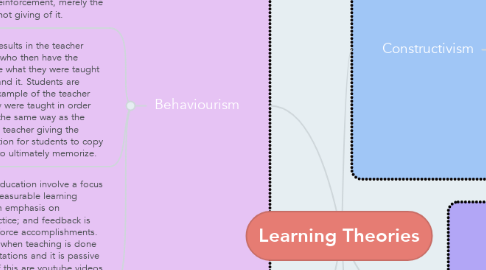
1. Behaviourism
1.1. This type of learning involves using repetition. It uses drills and uses the motto that 'practice makes perfect.' It also uses positive and negative reinforcement to enhance learning in order to increase desired behaviour. Punishment does not count as negative reinforcement, merely the giving of praise or not giving of it.
1.2. This type of learning results in the teacher lecturing the students who then have the opportunity to practice what they were taught until they can understand it. Students are meant to follow the example of the teacher and practice what they were taught in order to be able to do it in the same way as the teacher. It involves the teacher giving the problem and the solution for students to copy and practice in order to ultimately memorize.
1.3. The implications for education involve a focus on observable and measurable learning outcomes. There is an emphasis on performance and practice; and feedback is given in order to reinforce accomplishments. Behaviourism is used when teaching is done through direct presentations and it is passive learning. Examples of this are youtube videos and Ted Talks.
2. Information Processing
2.1. This type of learning was made in order to learn in another way besides the way in which behaviourism promoted. This type of learning involves more involvement so that learning is active instead of passive. Learning is done through the processes of acquiring the knowledge and then remembering that knowledge to use. This type of learning thinks of the mind as a computer, unless it is in the long-term memory, it has not been learned. So, ultimately, this type of learning states that the student takes in the information found, learns it well enough that it stays in their memory, and then knows it well enough to be able to use it for other tasks. Focuses mainly on memorizing and learning in order to have the knowledge in the long term memory.
2.2. The implications for this type of learning involve a lot of memory. The purpose is to get the information into the students long term memory and this is done by practice, memory tools, mind maps, or other organizers.
2.3. This type of learning is demonstrated by this mind map. It involves using processing tools in order for the student to be able to aquire knowledge and then memorize it by applying it through the work of a mind map, or other tools. Information processing is mainly a way for students to use their already acquired knowledge and then demonstrate how it works.
3. Constructivism
3.1. This type of learning involves more problem solving skills. Instead of acquiring knowledge to learn and memorize, this type of learning involves students acquiring the knowledge through working out problems on their own. Teachers give students the problem who then have the opportunity to try and solve it on their own.
3.1.1. This type of learning involves the teacher merely as a facilitator. The teacher helps students learn the information when needed, but ultimately it is the students figuring out the problems on their own in order to learn the skills or problem solving. This can also include building objects that students can physically see and hold to help them remember certain topics. An example of constructivism used in class was the use of gizmos. By allowing students to figure out the game on their own, they are able to learn and discover what the gizmo is teaching, while using technology to do so. Using gizmos for learning, allows the students to discover the knowledge on their own instead of the teaching lecturing it to the students.
4. Connectivism
4.1. This type of learning states that learning involves creating connections and developing a network. Connectivism is a more recent type of learning intended for the digital age. Instead of memorizing everything, this learning promotes having different networks where one can access different sources in order to find the information needed. Learning is done by connecting to other networks containing information and knowledge. Instead of students trying to memorize everything, this allows for students to find the information on different networks whenever they need to access it.
4.1.1. Connectivism was used in our course when we were creating our PLN's. We used the network twitter, to make connections with other teachers in order to gain more knowledge on different approaches to teaching, and different activities to use.
